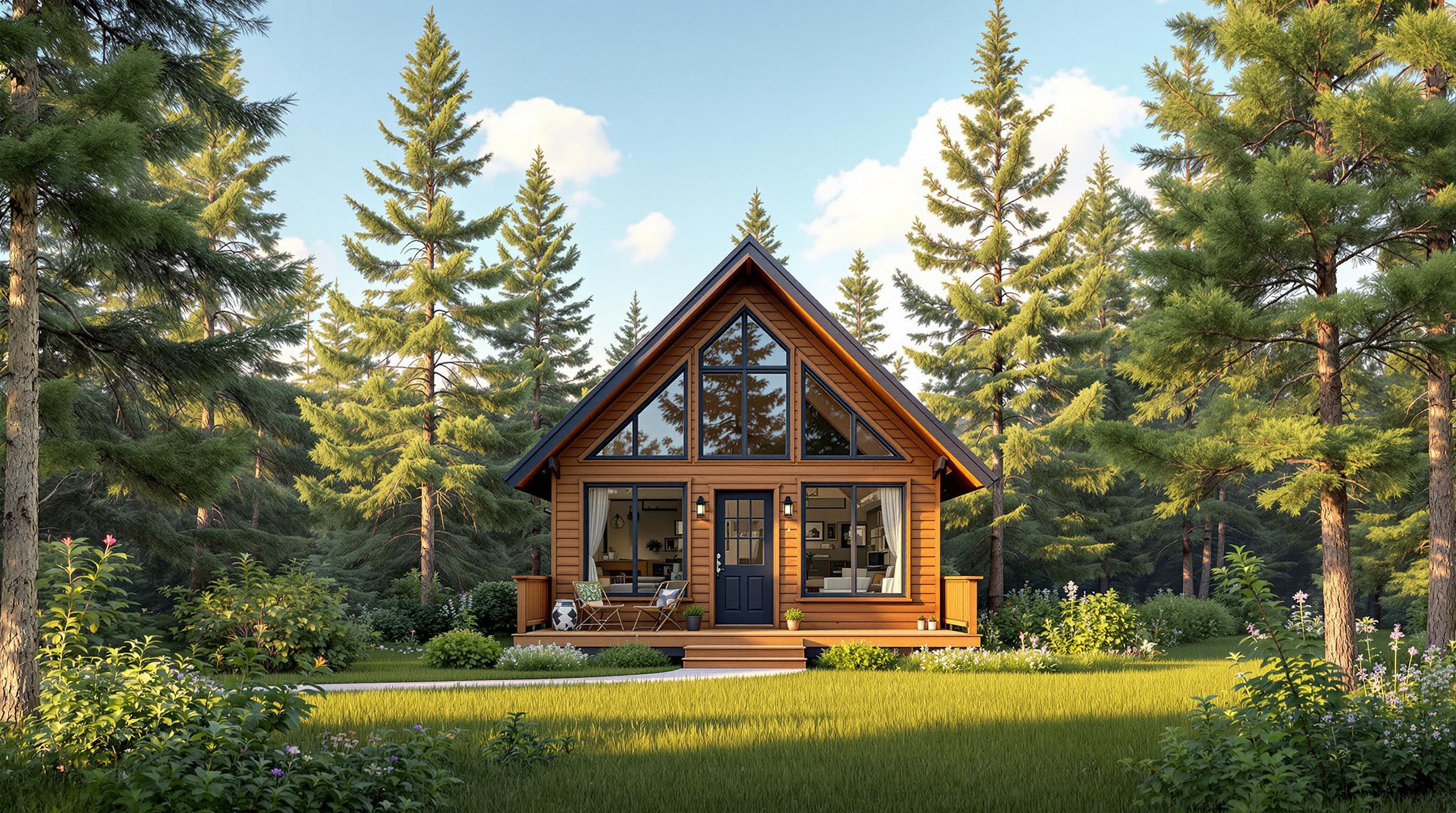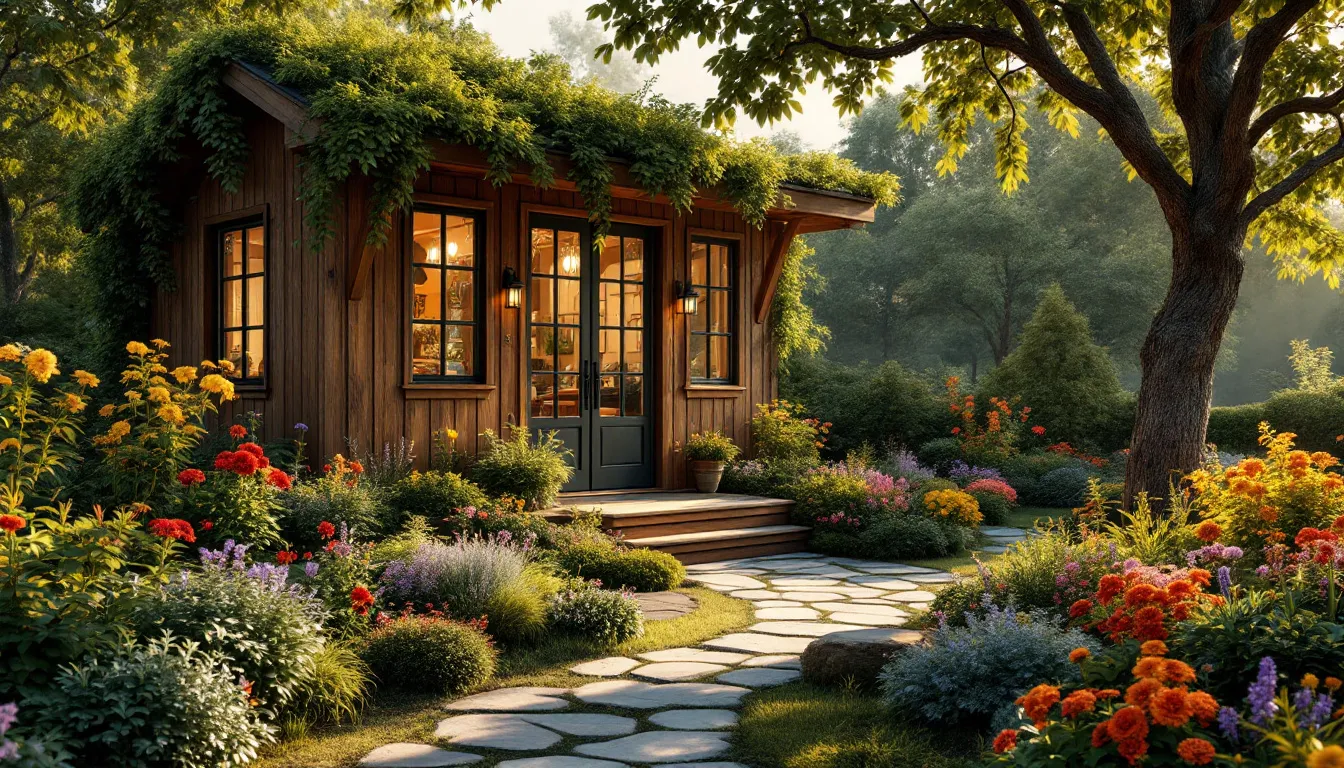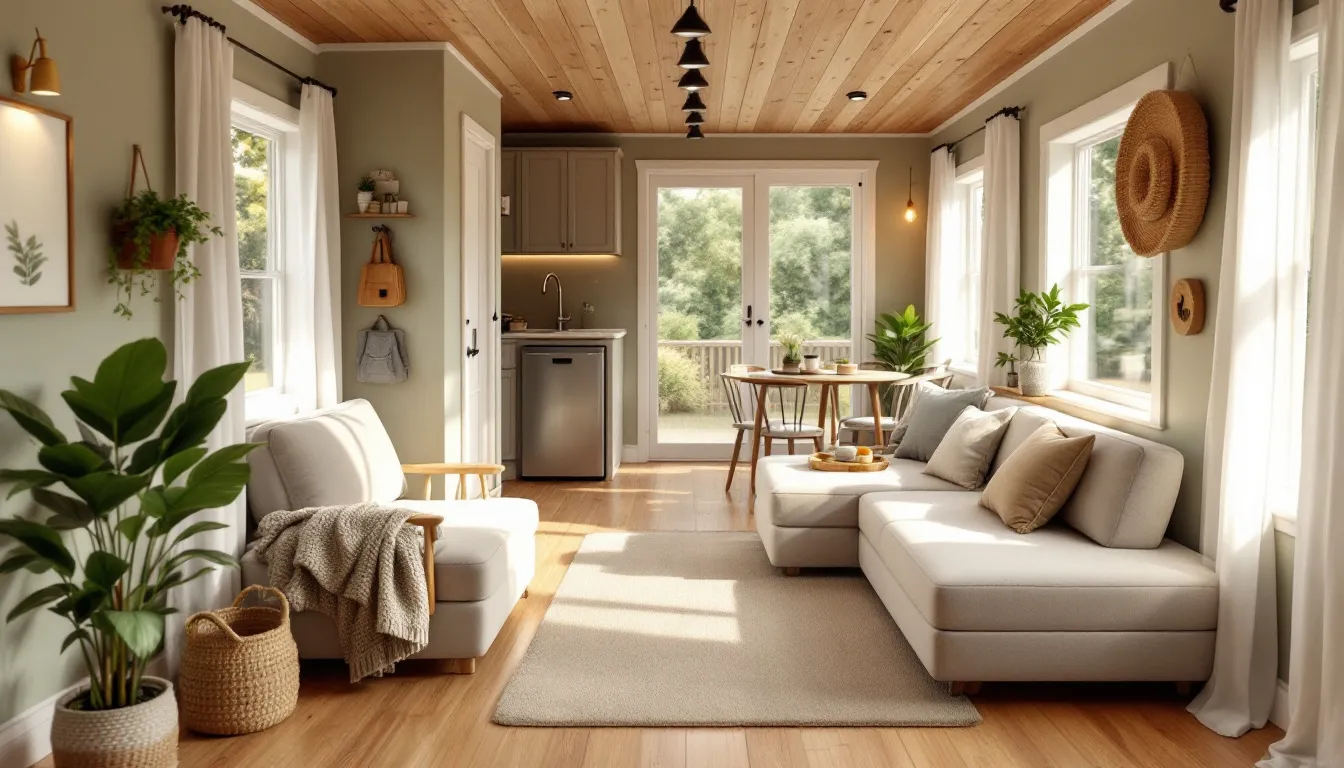Eco-friendly tiny houses combine small living spaces with sustainable practices, making them popular for reducing environmental impact. Here's a quick overview of what makes them stand out:
- Green Materials: Reclaimed wood, bamboo, and recycled metals are commonly used to minimize waste and promote durability.
- Energy Solutions: Solar panels, passive design, and smart energy systems make these homes energy-efficient.
- Water-Saving Features: Rainwater harvesting, greywater recycling, and low-flow fixtures reduce water consumption.
- Smart Design: Space-saving furniture, vertical gardens, and natural lighting improve functionality and comfort.
- Customization: Modular layouts, biophilic elements, and eco-friendly paints personalize these homes while staying sustainable.
These homes demonstrate how thoughtful design and efficient systems can create practical and eco-conscious living spaces.
Using Green Materials and Building Methods for Tiny Houses
Choosing Eco-Conscious Building Materials
Choosing the right materials is key to creating environmentally friendly tiny houses. Reclaimed wood, often sourced from demolished buildings or fallen trees, helps cut down on deforestation and waste while adding a unique look to your home [1]. Bamboo, a fast-growing material that requires little water and resists pests without chemical treatments, is another excellent option [1][3].
Other eco-friendly choices include recycled metals, which reduce the need for mining, and non-toxic paints, which improve indoor air quality. These materials work well for walls, floors, roofs, and even finishing touches. Using these options not only lowers the environmental impact but also boosts the durability and usability of tiny homes.
Building Methods That Reduce Waste
Tiny house construction often focuses on minimizing waste through smart building methods. Prefabrication, where components are built in factories instead of on-site, has become a game-changer. This process cuts down on material waste and ensures precise usage [2][3].
Another essential method is passive design, which emphasizes:
- Using the home’s orientation to make the most of natural light and heat
- Adding insulation to improve energy efficiency
- Incorporating natural ventilation to limit the need for mechanical cooling
A great example is Nestron's prefabricated tiny homes, which use recyclable materials and include features like solar-powered electricity and heating systems. These homes show how sustainable construction can lead to practical, energy-efficient living spaces [4].
Many builders aim for certifications like LEED to confirm their eco-friendly practices in material use and waste management [2]. Partnering with professionals who specialize in sustainable building is a smart move for anyone looking to meet their environmental goals.
Energy-Saving Systems for Tiny Houses
Using Solar Panels and Renewable Energy
A 2 kW solar panel system, positioned to capture maximum sunlight, can provide enough energy for a tiny home’s efficient appliances [1]. When combined with battery storage, these panels ensure steady power supply while minimizing waste.
Smart energy systems take things a step further by monitoring and adjusting power use throughout the day. For example, the Nestron Cube One showcases how a fully integrated solar setup can meet all energy needs without compromising on comfort [4].
Saving Water with Smart Systems
Efficient energy use is just one part of the equation - water-saving systems play a crucial role in tiny house sustainability. Rainwater harvesting systems can supply water for tasks like flushing and irrigation [2].
Features such as greywater recycling and low-flow fixtures can cut water usage by up to 50%, helping conserve resources and lower bills [2]. Greywater systems repurpose water from sinks and showers for non-drinking purposes, creating a smart and efficient water management setup.
To keep these systems running smoothly, regular maintenance is key. Together, these energy and water-saving solutions not only reduce utility costs but also help tiny homeowners minimize their environmental footprint.
Smart Design Ideas for Small Spaces
Space-Saving Furniture and Layouts
Modern tiny homes are all about furniture that serves multiple purposes. Think sofa beds with hidden storage or coffee tables that convert into dining tables. These pieces pack a punch by combining functionality with a sleek, uncluttered design [2]. They allow living spaces to shift and adapt throughout the day, offering both practicality and comfort without sacrificing style.
Bringing Nature Indoors with Design
Designing with nature in mind can transform small spaces while promoting eco-friendly living. Features like large windows let in plenty of natural light, reducing the need for artificial lighting and creating a seamless connection to the outdoors [4]. Vertical gardens not only freshen up the air but also take up very little space. Skylights brighten interiors and make rooms feel larger, while bamboo partitions work as flexible, environmentally friendly dividers.
Using natural materials, like charred wood, adds a bold, earthy touch that complements sleek interiors. These elements don’t just look great - they also cut down on the need for artificial lighting and air purifiers, making tiny homes more energy-efficient and eco-conscious [4].
Clever Storage Solutions for Tiny Homes
Smart storage is a game-changer in tiny homes. Floor-to-ceiling shelves and pull-out pantries make use of vertical space without sacrificing convenience [1]. Other clever ideas include built-in storage walls, under-stair compartments, and using the often-forgotten spaces above doorways.
By extending storage upward, these solutions not only boost capacity but also draw the eye upward, making ceilings seem taller and rooms feel more open [2]. It's all about finding ways to make every inch count while keeping the space functional and accessible.
With these design ideas, tiny homes can be customized to align with personal eco-friendly living goals.
Customizing Tiny Homes for Green Living
Personalizing Tiny Houses with Eco-Friendly Choices
Using natural materials is a popular way to add a personal touch to tiny homes. Reclaimed wood can bring character to walls and furniture, while bamboo offers a stylish and sustainable choice for various design elements [2]. These materials not only create cozy, welcoming interiors but also help lower the environmental footprint.
For a safer and greener home, consider plant-based paints with low VOCs and natural fabrics like wool or hemp [5] [2]. Adding biophilic design elements, such as stone or wood, can enhance the connection to nature while making your space feel uniquely yours [2] [3].
While these customizations provide immediate charm, it's also worth thinking ahead to ensure your tiny home remains functional and eco-conscious over time.
Planning Tiny Homes for Long-Term Use
Designing for the future means creating a tiny home that evolves with your needs without compromising its eco-friendly values. Modular layouts and flexible designs make it easier to adjust your space as life changes [2].
Incorporating smart systems can improve both comfort and efficiency by saving energy and adapting to your usage patterns [1] [2]. Modular furniture is another practical choice - it minimizes waste by adjusting to different needs, while durable materials reduce the need for frequent replacements, keeping your home sustainable for the long haul [5].
sbb-itb-2ef3f3a
Modern Tiny Homes Design: Cozy Interiors with Sustainable & Eco-Friendly Plans
Comparing Green Options for Tiny Houses
Looking into eco-friendly options ensures your tiny house is both practical and better for the planet over the long haul.
Comparing Green Building Materials
Picking the right materials for a tiny house means weighing cost, durability, and environmental impact.
| Material | Cost | Durability | Environmental Impact | Best Used For |
|---|---|---|---|---|
| Reclaimed Wood | High | 20+ years | Reduces waste, minimal footprint | Siding, flooring, interior walls |
| Bamboo | Moderate | 15-20 years | Renewable, low impact | Flooring, cabinets, decor |
| Recycled Metals | Moderate | 30+ years | Cuts mining needs, low footprint | Roofing, structural elements, siding |
Your choice will depend on what’s available locally and how the material performs in your area. For instance, bamboo is a great pick for humid climates because it naturally resists moisture [2].
Comparing Energy-Saving Systems
Energy-efficient systems are key for making tiny homes more eco-friendly. What works best for you will depend on your location, budget, and energy needs.
| System Type | Initial Cost | Monthly Savings | Installation Requirements | Maintenance Level |
|---|---|---|---|---|
| Solar Panels | $8,000-15,000 | $100-200 | Needs roof space, good sunlight | Low |
| Wind Systems | $5,000-12,000 | $60-150 | Requires open, windy area | Moderate |
| Water-Saving | $2,000-5,000 | $30-80 | Requires plumbing updates | Low |
Water-saving systems, like rainwater collection, are a popular choice for cutting costs while being eco-conscious [2]. Many tiny house owners combine multiple systems to boost efficiency and ensure consistent performance throughout the year [3].
Conclusion: Steps Toward Greener Tiny House Living
Building an eco-friendly tiny house is now easier than ever, thanks to a variety of sustainable materials and efficient systems available for both new builds and renovations. The journey to greener living starts with thoughtful choices in materials and systems, supported by advancements in technology and smart design.
Incorporating natural elements into your tiny house not only reduces environmental impact but also enhances your well-being. Features like biophilic design improve air quality and promote a sense of connection to nature, boosting mental health in the process [2][3]. On top of that, smart home systems help you manage resources more effectively without sacrificing comfort [1][2].
Here’s a simple framework to guide your tiny house project:
| Phase | Goals | Action Steps |
|---|---|---|
| Planning | Design & Materials | Use locally sourced, renewable materials; prioritize efficient layouts |
| Building | Systems Integration | Add solar panels, smart water systems, and proper insulation |
| Living | Daily Operations | Track energy use, reduce waste, and maintain systems regularly |
The key to success lies in balancing eco-friendly choices with your personal lifestyle needs. Energy-efficient appliances and natural lighting, for instance, can create a cozy space while lowering your environmental footprint [2][3]. Every decision, from selecting materials to installing systems, plays a role in achieving sustainability.
Staying committed to greener living means keeping up with new practices and technologies. Start with the basics - renewable materials and efficient systems - and make updates as better options become available. Regular maintenance and a willingness to adopt improved methods will ensure your tiny home stays both environmentally responsible and aligned with your changing needs.
FAQs
What are some green solutions for tiny homes?
Tiny homes can adopt a variety of eco-friendly features. For example, solar panels designed for compact spaces can effectively handle energy demands [4]. Companies like Nestron have demonstrated how renewable energy systems can work alongside smart water-saving fixtures in tiny home designs [4].
Using sustainable materials is another key approach. Options like reclaimed wood, bamboo, recycled plastics, and low-VOC paints not only minimize environmental impact but also ensure functionality and style [2][3].
How to make a tiny house environmentally friendly?
The eONE XL model highlights eco-friendly design with its charred wood exteriors and large windows for better energy efficiency [4]. To make your tiny home more sustainable, consider these strategies:
- Maximize natural light with skylights and energy-efficient windows to cut down on electricity use.
- Install smart water heating systems and energy-saving LED lighting.
- Choose sustainable materials for construction and finishing touches.
- Incorporate natural elements to improve indoor air quality and overall well-being.
Additionally, opt for multi-functional furniture and built-in storage to save space while staying eco-conscious [2][3]. Combining these elements thoughtfully ensures your tiny home aligns with environmental goals without compromising on comfort or practicality.



